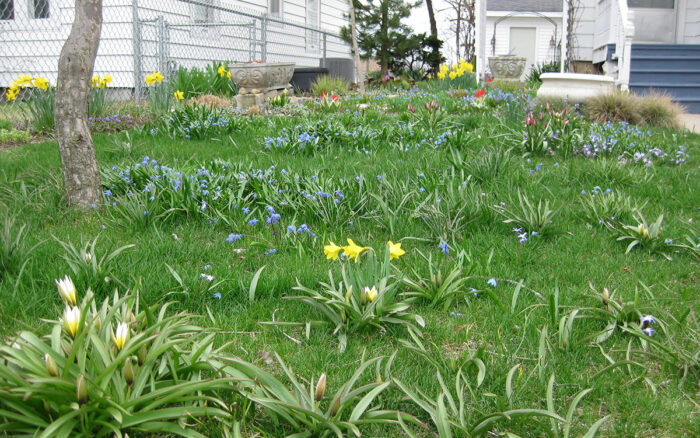
As we head into the spring months after a cold and snowy winter, most of us in the Midwest are looking at drab expanses of turf that are still coming out of dormancy. This inevitably leads to us gassing up the mower, sharpening the blades, and waiting for the annual commencement of our mundane turf-care routines. While you wait, why not consider that prime “real estate” for something more colorful and engaging? Consider creating a “bulb lawn,” which adds early color, pollinator value, fragrance, and ultimately, a more interesting transition to spring.
Most of us have some experience with or awareness of how to plant spring-blooming bulbs in our landscapes the previous fall. We dig holes for our tulips (Tulipa spp. and cvs., Zones 3–8), daffodils (Narcissus spp. and cvs., Zones 3–9), hyacinths (Hyacinthus orientalis and cvs., Zones 5–9), and so on and look forward to their spring contributions. Establishing a bulb lawn is no different in terms of the process, although there are some more-subtle nuances to contend with in terms considering the turf and selecting appropriate bulbs for this purpose.
First, the bulbs that you consider for this purpose should all be very early–flowering varieties. The reason for this is that their contribution comes early, and as they go dormant, you are heading back into your normal lawn-care cutting routine. It is important to note that in any area dedicated to a bulb lawn, you need to be willing to allow the grass to grow a bit longer with that initial spurt of growth as it coincides with leaving your early bulb foliage photosynthesizing and later going dormant.

Some bulbs to consider for lawn planting include crocus (Crocus spp. and cvs., Zones 3–9), winter aconite (Eranthis hyemalis, Zones 3–7), snowdrops (Galanthus spp. and cvs., Zones 3–9), various squill (Scilla spp. and cvs., Zones 3–9), striped squill (Puschkinia scilloides and cvs., Zones 3–9), glory-of-the-snow (Chionodoxa spp. and cvs., Zones 3–9), and grape hyacinths (Muscari spp. and cvs., Zones 2–9). Other considerations include early tulips, daffodils, and early irises (Iris spp. and cvs., Zones 3–10). There is a wide spectrum of bulbous options, but again, do consider the earliest-blooming species.
When planting, choose an area of turf that can again be left a bit “untidy” in the early part of the year, and scatter bulbs in a random pattern. In planting through the turf, use a bulb planter to remove sections of turf, and install bulbs at a depth of three times their height. (This is a typical rule of thumb for all bulb planting.) Larger sections of turf can be cut and rolled back to create larger access to planting, but getting the turf out of the way is ideal for planting directly in the underlaying soil.
After planting the bulbs, the turf you removed should go right back into place, tamped lightly, and immediately watered. Consider animal repellents as needed as you would with other bulbs in the landscape. Upon emergence, these beautiful, early-flowering selections provide much-needed pollen and nectar for area pollinators as the weather warms.

As the spring bulbs emerge, bloom, and fade, it’s important to wait to cut the lawn for roughly six weeks while the bulb foliage naturally dies back. The grass does get to be a bit scraggly along with the bulb foliage. However, the timing actually works about perfectly with No Mow May, a conservation initiative that supports bees and butterflies in the early part of the growing season by delaying spring lawn mowing. Once the bulbs have faded to dormancy, the grass will be long. You can make your first cut with a string trimmer (with some raking to follow), or you can simply set your mower blade up higher and repeat mow as needed to tidy up.
These bulbs will multiply over the years and offer decades of enjoyment if properly maintained. The additional color and interest of a bulb lawn is worthy of consideration for maximizing the ornamental appeal of your turfgrass areas in spring.
—Mark Dwyer is the garden manager for the Edgerton Hospital Healing Garden in Edgerton, Wisconsin, and he operates Landscape Prescriptions by MD.


















Comments
Log in or create an account to post a comment.
Sign up Log in